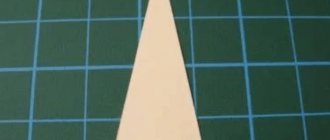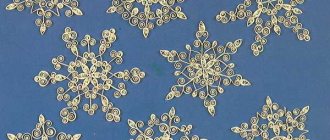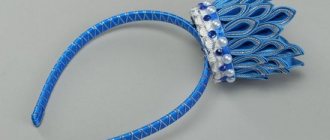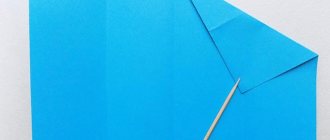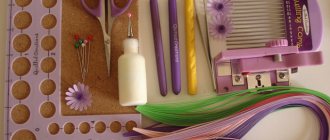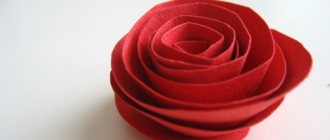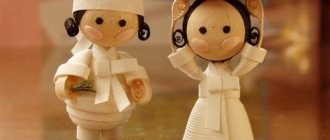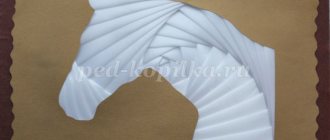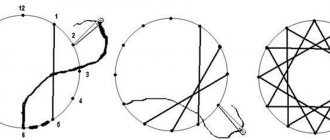Each of us should have our own hobby that brings pleasure and allows us to create something amazing. If you haven't found your favorite activity yet, be sure to try quilling! This activity is suitable even for small children, as it helps develop motor skills. However, adults also enjoy quilling and create truly amazing pieces.
The art of paper rolling
Quilling is the art of paper rolling, that is, making flat or three-dimensional compositions from long and narrow strips of paper twisted into spirals. The finished spirals are given different shapes. This is how modules are obtained from which works are created - paintings, postcards, albums, frames, figurines, etc. The art of paper rolling arose at the end of the 14th century in Western Europe. It is believed that quilling was invented by monks. By trimming the gilded edges of the books, they wound them onto the tips of bird feathers (hence the name, since quill in English means “bird feather”) and thus created an imitation of a golden miniature.
In the 15th - 16th centuries, paper rolling was considered an art; in the 19th century, it was considered a ladies' pastime (and almost the only handicraft worthy of noble ladies). In the 20th century, interest in the quilling technique faded, and only at the end of the century the art of paper rolling again entered the lives of creative lovers.
The Korean school of quilling techniques differs from the European one. European works, as a rule, consist of a small number of parts; they are laconic, reminiscent of mosaics, and decorate postcards and frames. Eastern masters create complex works that are more like masterpieces of jewelry. The finest volumetric “lace” is woven from hundreds of small parts.
Another manufacturing technique that deserves special attention is contour quilling. Works using this technique are also created from long narrow strips that are placed on the edge. Due to the use of the same material, this technique of working with paper is also called quilling, but due to the fact that the stripes are placed on the edge, the pattern is contoured. The products look more vibrant and realistic. And “mixed” works look especially good, where both quilling techniques are used - regular and contour.
Let's start making giraffe quilling
The photo below shows options on how to make a giraffe if you are a beginner in this type of needlework.
The first picture shows a giraffe made of parts that are loosely wound onto an orange stick, and then compressed into “droplets” (that is, squeezing a circle on one side), “eyes” (this is the shape a circle takes on if you squeeze it on both sides ) as well as “diamonds” (to make them, you need to squeeze the circles on four sides. Two sides need to be squeezed tighter, and two more a little weaker). You should not rush to glue all the figures onto the paper at once and fix them together, as the giraffe may not turn out right away. You should first lay out each piece on cardboard or a sheet, and only then take each of them and glue them in place.
As for the second photo, in it the giraffe is quilled from round figures and “droplets”. The principle of making such a craft is the same as in the first case:
Tools and materials
Before you start quilling, you need to know what you need for the job. Next, you will learn what tools and materials beginners need for the quilling technique.
Paper. Quilling uses long paper strips, which come in widths of 3 mm, 5 mm, 7 mm, 10 mm and 1.5 cm. You can cut the desired strips yourself with scissors. There are also special desktop machines for cutting paper into strips for quilling. But it is necessary to take into account that the quilling strips are the same color on all sides, i.e. not only on the wide side, but also on the edge side, while ordinary colored paper, if cut, often gives a white edge color.
The strips come in different densities, metallized, with glitter, etc. Which stripes to choose depends solely on your imagination and the future painting.
Stripes can be purchased in one color or with transitional tones in one set. There are sets of different colors. As a rule, the length of all strips is about 30 cm (length of AA sheet). If necessary, you can make the strips shorter by cutting them, or longer by gluing several strips together.
Pen. Typically, this tool is simply called a “quilling tool.” It comes in metal and wood, double-sided, single, only with a fork and a ball. What is it?
In essence, it is a handle, at the end of it there is a fork, into the slot of which a strip of paper is inserted and twisted. The fork comes in different heights: 3 mm, 5 mm, 10 mm, 1.5 cm, i.e. corresponds to the same parameters as paper. It is best to have several tools in stock, for example, 5 mm will work for 3 mm and 5 mm, and 1.5 cm will work for 10 mm and 1.5 cm. These can be two different tools or one tool with two tips.
You can even make do with improvised means - use a toothpick, a needle or a match. You can make the tool yourself: take a needle with a large eye, bite off the small tip of the eye (you get a fork), and stick the needle itself into a cork or wooden handle.
Diameter template. When talking about quilling tools and materials, we must not forget about templates. This is a regular ruler with circles of different diameters. It is convenient to use it to create elements of the same size: having twisted the desired spiral, you place it in a circle of the required diameter, and measure all the rest along the same circle.
As a rule, in our stores they sell rulers only with circles, but if you want to delve deeper into this type of creativity, I recommend that you look at foreign websites for rulers, which will contain templates of all geometric shapes.
Tweezers. There are tweezers with different noses, the most popular is with an angled nose, i.e., with the nose pointing down. But you can also use stationery tweezers (if you don’t have one, you can take tweezers from a manicure set). Tweezers are used not only to lay out the finished modules during assembly, but also to firmly press the tip of the paper strip against the spiral when gluing.
Glue. PVA is best, but a good glue stick, craft glue, or clear glue will also work. The most important thing is to apply very little glue so that the paper does not deform.
What additional tools are needed for quilling? Every year, a new collection of tools is added to improve the quality of your work while reducing costs. There are various templates for making flowers, snowflakes and other objects, a machine for creating corrugated strips, a quilling coach (a tool for making even spirals), “combs” for creating looped quilling, etc. Quilling paintings consist of small parts called “modules”. Modules come in different forms. They are always created according to the same principle: first the roll is twisted, after which it “unfolds” slightly, and the tip is sealed. Such a part is called a “spiral”, and modules are created from the spiral by applying different pressure on it.
Quilling for Beginners
Quilling Tools
For quilling you will need some tools:
- scissors
- paper rolling tool (can be replaced with a toothpick, a needle with a slot, etc.)
- tweezers
- a ruler with circles of different diameters (to create identical parts for the product).
Tools for quilling
To create more difficult parts, tailor's pins will also come in handy, a paper crimping tool, etc. may come in handy.
But don’t be scared, for starters, as already mentioned, all you need are strips of paper, glue and a pin. But if you do this seriously, you will have to spend a little money.
Quilling paper
You definitely need colored paper on both sides, otherwise the products will turn out, to put it mildly, not very well. The minimum density is 100 g, it is best to buy paper with a density of 115 to 160 g. Most often, strips 3-5 mm wide are used, but wider ones are also found.
Quilling paper
There are separate stores for quilling; they will find everything you need, including paper. You can also simply cut A4 paper into strips.
Here's a life hack - many people use a shredder, also called a shredder, to create even strips. If necessary, the strips can be cut and glued, for example, with a second strip of a different color. You can also color the tip or edge with ink.
Quilling technique - main details
Even a schoolchild can do basic quilling details:
Simply wrap the strip around a toothpick or other object and then release it. The part straightens out - it is a free spiral. After the part is straightened as needed, glue the end with glue. This is the most basic technique. When creating others, build on it.
Free spiral
Drop - squeeze one edge of the spiral.
A drop
Curved drop - make a drop, the end of which is slightly bent.
Curved drop
Eye – squeeze both edges.
Eye
Leaf - make an eye, bend the ends in different directions
Sheet
Triangle - hold one side of the spiral with one hand, the other with the other, bend it. A semicircle has formed. Squeeze the middle of the semicircle again.
Triangle
Arrow - make a triangle, at the base of which squeeze the edges towards each other.
Arrow
Crescent - squeeze both ends of the spiral and bend them.
Crescent
There are many more details, but these are the most basic. You will learn about others when you take master classes.
Basic modules
Various elements are used to work in the quilling technique.
Tight spiral - twist the ribbon and glue the tip without removing the spiral from the needle so that the ribbon does not unwind.
Donut - Before making this one of the basic elements of quilling, twist a tight spiral, slightly loosen and untwist the inside so that there is an empty space.
Donut with a spiral - twist a tight spiral, slightly loosen so that there is more paper at the edges, but do not unravel completely.
Tight oval - take a pen or pencil, wrap a strip of paper around it and glue the tip. As a result, you will end up with a bagel with a large hole. Then press lightly with your fingers on both sides, giving the module an oval shape. Free spiral - twist the tape, loosen it a little to the desired volume and glue the tip.
A drop is one of the basic elements of quilling. Make a loose spiral and compress it on one side, giving it a teardrop shape.
Petal - make a drop quilling module and lightly pinch the rounded tip. You can pinch at different levels, thereby changing the shape of the petal. Curved Drop (Paisley) - There are two ways to make this module. The first is to make a drop, and then bend it in the desired direction. The second, and more accurate, way is to bend and create a drop at the same time. Then the paper will fold evenly and neatly.
Eye - make a loose spiral, then pinch on both sides at the same time, trying to maintain symmetry.
Curved petal - make a free spiral, press lightly, giving the workpiece an oval shape, then pinch and bend first on one side, then on the other. When making this element using the quilling technique, do not forget that you need to bend it in different directions - one side down, the other up.
Bird's foot - make a loose spiral, squeeze the triangle. Fold two corners towards the third and press firmly.
Flower (or circle with a notch) - make a free spiral and, holding the workpiece with your fingers, press it on one side with a pen or pencil.
Lily of the valley - make a flower module and curl the ends outward using an awl or the base of a quilling tool.
Next, you will learn how to make geometric elements using the quilling technique.
Quilling. The flower is simple.
Let's start with the simplest flower.
1.
Prepare a square sheet of colored paper. Its dimensions should be approximately 10x10cm.
2.
Draw a spiral inside the square.
3.
Using scissors, cut a spiral along the drawn line.
4.
Using a special quilling tool (which can be replaced with an awl, needle or toothpick), twist the paper into a spiral.
You should end up with a rose like this. By making several of these flowers, you can come up with a beautiful composition.
Rose using quilling technique (video 1)
Rose using quilling technique (video 2)
Geometric elements
Square - make an “eye” module, place it between the thumb and forefinger so that the corners are clearly under the fingertips. Now squeeze the module and release. You have four equally spaced corners and can form a square.
Triangle - Make a loose spiral and squeeze it in three places to make a triangle.
Semicircle - make a loose spiral, press it lightly with your fingers, giving it a slight oval shape. Now pinch the “sharp” parts of the oval and lower it down slightly.
Arrow 1 - make an “eye” module, then secure one corner between two fingers, and press the other corner so that you get a sharp triangle. Release and you will see that you have formed four corners that resemble an arrow.
Arrow 2 - make a loose spiral, compress it into a triangle. Press the two corners together to create an arrow.
Star - pinch five times at an equal distance.
Open quilling elements are those used to create a composition that do not need to be glued together, i.e. close. They are created by twisting the tape in one direction or the other.
Below you will learn about the step-by-step quilling technique when performing various applications.
Craft "Lavender"
The most common form of quilling is floral motifs of varying complexity. The following is a description of creating a simple version using the quilling technique, which will allow you to understand all the basics of creating, constructing and combining elements.
To make the “Lavender” applique using the quilling technique you will need:
- paper base
- strips for quilling division and lilac (you can take 2 lilac colors - one for flowers, the other for the bow)
- template line
- PVA glue
- quill tool
- glue brush
First, we twist spirals from one strip, unravel them equally using a ruler with a template, glue the tail and lightly squeeze it, turning it into an oval. Such modules must be made at the rate of 9 pieces per flower.
Making the stems. To do this, glue 2-3 green strips so that they are better visible, spread glue on the edge and place the strip with glue on the paper. Do not glue the bottom of the strip yet.
Assemble the finished parts.
Now we make leaves. To do this, twist a spiral of 2 strips and give it a “Curved Petal” shape.
Let's move on to creating the bow. First, let's make the ribbons. They are made in the same way as leaves, i.e. have a “Curved Petal” shape. It is enough to take 1 lilac spiral.
Now, when working with paper using the quilling technique, we make the bow itself. We twist a spiral from two strips, unravel it and squeeze it so that we get a shape similar to a heart.
We add new modules to the already glued ones.
To finish creating the bow, cut small strips of the same color as the bow itself and simply glue them between the stem and the bow. Arrange the ends of the stems as you like and secure them with glue.
Below we describe step by step how to make a picture “Owl” using the quilling technique.
How to use contour quilling technique (video)
Knowing all the nuances of creating contour quilling, you can completely immerse yourself in your imagination and create unique masterpieces. The main thing is to choose the right materials and tools, this will make the work easier. The principle of contour quilling is to apply an image to thick paper. Then, one by one, apply glue and fix all the parts. You can create a wave-like shape by first twisting a strip of paper. Then spin it slightly and form a wave. The letter or number is decorated gradually so that the result is satisfactory. But not too much, otherwise you might just overdo it.
Picture "Owl"
Creating such work is technically just as easy, but requires more time, because... There are much more details.
You can prepare a sketch in advance, you can improvise, letting your imagination run wild when drawing the details of this cute owl.
To create the “Owl” composition using the quilling technique you will need:
- base paper of at least A4 size
- quilling stripes: burgundy, dark blue, black, two types of gray, as well as a little white, beige and green for the eyes
- PBA glue
- quilling tool
- tassel
- template line
Let's start with the eyes. To do this, take half a black stripe, half a white stripe, one whole green stripe, one brown stripe and half a dark blue stripe. Twist everything into a tight spiral.
Using two burgundy stripes and one blue, twist the spiral, unravel it, glue the tip and make a crescent module. Two such parts need to be prepared.
Using 1 blue and 1 black stripe, make a curved petal module. You also need two of these parts.
Using 1 burgundy and half a blue stripe, make a teardrop module.
We assemble the modules to form the face of an owl.
We make two small triangles each from one black stripe.
We substitute them to the formed face.
We make many “petal 2” modules from burgundy stripes. One strip is enough to create a module.
We substitute ready-made modules, forming the body of an owl.
Now we create many spirals using gray, blue, black colors.
Since these are future feathers, they need to be made in different sizes - from larger to smaller.
The large feather will consist of one whole gray, one whole blue and one whole black stripe.
Next, reduce each of the stripes a little, so you get a smooth transition.
We assemble wings from ready-made modules. If you used two types of gray stripes, alternate them with each other.
We use the same principle to make the inner feathers. They can be any color and size.
We decorate the spaces between the feathers with small tight spirals.
Making the tail. To do this, you need to make feathers of different lengths - from longer to shorter.
To make the tail beautiful and different from the wings, we will decorate the feathers with tight spirals.
Glue a tight spiral to the finished feather and cover the entire part with an additional dark blue or black stripe.
To give the owl a more complete look, make two banana-shaped modules and one complex module with a triangular edge.
To do this, use the instructions for creating a semicircle and pinch one side to create a corner.
We substitute the finished modules for our owl. “Bananas” will frame the wings, another detail will complete the bird’s head. The picture is ready.
The next section of the article describes how to make the “Delicate Flowers” quilling craft.
Composition “Flowers”
To make a “Flowers” craft from paper using the quilling technique, you will need:
- A4 size base paper
- quilling paper yellow, cream, pink, green in several shades
- template line
- PVA glue
- glue sealant or hot gun
- quilling tool
We will do this work with elements of contour quilling - two hearts in the center will be made using this technique.
To do this, take 10 pink strips and glue them together, gluing each subsequent strip slightly lower than the previous one.
Then we twist the resulting strip and release it.
Glue the edge of the resulting curl. From two such parts we form a heart.
Let's move on to creating flowers. Flowers are created from individual petals. From two cream and two yellow stripes, twist a spiral and unravel it.
Then squeeze the piece slightly and wrap it around something round, like a pencil. Pinch the edges and pinch the center to create a sharper petal shape.
Glue the ends of the petal together and secure with a clothespin.
For each flower you need to make 6 such petals.
Now we will make simple small flowers. Tight spirals will be the center of the flower.
Spirals of two stripes will become the core of large flowers, and spirals of one strip will become the core of small flowers.
After making the right amount of details for the flowers, also make a lot of paisley modules to create greenery around the flowers.
Now we begin collecting the work. First we glue the hearts.
In order to make the flowers more voluminous, it is necessary to secure the petals at an angle.
To do this, you need to use a glue gun or glue sealant.
This glue not only sticks the petal to the base paper, but also creates a cushion that lifts the petal.
Step by step we glue the flowers.
Then we frame them with green modules.
To create volume, glue some modules on top of each other.
Use tight strands to further decorate your work.
The next section of the article will be devoted to how to make a “Firebird” product step by step using the quilling technique.
Paintings using quilling technique: what is needed for work
So, if you decide that quilling is the most interesting type of applied art for you, you can try to create paintings and crafts from paper strips yourself. To do this, you need to prepare properly.
To work you will need:
- Paper strips of special paper. This is double-sided colored paper. It may already be cut into thin strips, or it may be solid sheets, and then you will need a special device for even cutting of the paper.
- Tools for working with paper: tweezers, scissors, needles. Also, on the modern “market” you can purchase special devices designed to better give paper the shapes you need, for quickly rolling paper strips, and so on.
- And most importantly: a lot of patience and accuracy in work, which is especially important for beginners.
All necessary materials for quilling are sold in a craft store.
Paintings made using this technique can be both large and small, it all depends on the imagination and theme that is displayed in the resulting picture.
After finishing the work, the finished paintings can, and even should, be framed and hung on the wall or gifted to a loved one.
This is a wonderful gift for a birthday or other holiday. In addition, as you can understand from exhibitions of modern talented quilling masters, such voluminous paper lace can be sold. To do this, various resources and exhibitions can serve to help beginning craftsmen.
Product "Firebird"
It is better to create more complex works with a prepared sketch. Draw what you want. There is no need to draw every module and all the colors; it is enough to determine the general color scheme and those modules that are important for conveying your idea. Here's another idea using the quilling technique.
For the “Firebird” product using the quilling technique you will need:
- base paper no less than A3
- quilling paper
- quilling tool
- PVA glue
- needles or comb for quilling
We will create not only single-color contour modules, but also rainbow ones. To do this, several strips of different colors are glued together. We can mix as many colors as we want, in any order. It can be a smooth transition from yellow to red, then when twisted, this gradient will go from the center outward. Or it can be contrasting colors, then one color will frame the other.
We twist loose spirals of different sizes and colors.
Then we give them the desired shapes: drops, paisley, semicircles, petals, arrows, tight spirals.
It is better to assemble some elements separately.
Now we will make beautiful curved lines, the same method is used in contour quilling. Choose the colors you want to make a curl from and glue the strips on top of each other at the tip. The more stripes, the more “lush” curl you will get.
Then twist into a spiral, but not tightly, so that the strips do not touch when wrapping.
Remove the spiral from the tool and loosen it slightly.
Next, we model the shape with our hands - bend it, twist it if necessary.
Now we glue the strips one by one, from bottom to top, each time slightly loosening the tension of the strip to create space.
In this way we create the number of curls we need in different sizes, colors and shapes.
There is a technique in quilling called “quilling with a comb.” The name speaks for itself - the elements here are created by winding paper in different ways onto the combs of a flat comb. We will not go deep into this method, we will only master the simplest way to create a module using this technique, and for this we do not necessarily need a comb! After all, we are making a fairly large object; in our case, there is no point in winding strips around a comb. Using needles and foam, we will create our own “comb” on a large scale.
Glue together several strips. Carefully wrap the resulting long strip around the needles, making sure to pinch at the base. This is necessary not only for convenience, but also in order to create the correct shape. If you don't pinch, the strip will start to loosen the tension and you won't get the shape.
Having completely wound the strip, glue the tip, and also drip a drop of glue at the base so that all rows stick.
Using this technique, we create the required number of elements of different colors and sizes. Please note that the arrangement of the needles can be changed each time, or you can leave it the same.
Having made the main part of the elements, we assemble our bird, but do not glue it.
Some details can be emphasized favorably by combining them with each other: for example, so that the bird’s body does not merge with the wing and tail, it can be covered with a contrasting stripe.
Now the assembled parts can be glued. Strive to glue the parts tightly together, then the picture will look more openwork, and the background will be barely noticeable.
To fill the resulting voids, it is not necessary to manufacture new modules. It will be enough to make tight spirals of different colors and sizes. They will not only fill the space, but also visually enrich and complicate the design.
After assembling and gluing the bird, you can think about what will surround it.
But don’t overdo it, our bird itself turned out to be very bright, rich in elements, so it will be enough to make a small green twig and a small bud.
Below we describe how to make a “Vase” craft from paper using the quilling technique.
Craft “Vase”
Creating figures from quilling modules is, on the one hand, a very easy task, but on the other, it is extremely difficult.
But the whole difficulty lies only in fastening the parts and their correct fixation.
To make a “Vase” craft with your own hands using the quilling technique, you will need:
- quilling paper of any colors
- PVA glue
- adhesive sealant
- quilling tool
First we create the bottom of the vase. To do this, we twist a large tight spiral and paste it with small tight spirals.
We cover the glued spirals with yellow stripes.
Next we will create the sides of our vase.
If the vase is straight and does not expand upward, then it is enough to evenly glue the finished modules tier by tier.
If you need to give it a bending shape, use adhesive sealant.
Drop it onto the edge of the module using the same principle as in the master class on creating delicate flowers, and fix it in the desired position.
While the sealant is drying to prevent the modules from slipping, place something that will hold the parts in place.
Make as many tiers as you like.
In this case, you can use modules of different shapes.
To further decorate the vase, make regular flowers and then stick them on the vase.
The vase is ready. All you have to do is let it dry completely, and you can put something tasty in there.
Now you know how to do some quilling work, which means you can start practical tasks.
0 Comments
